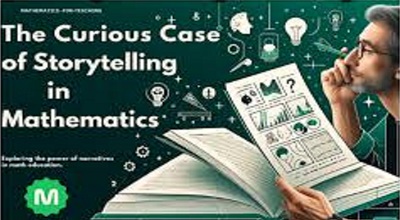Math as a Narrative
Math as a Narrative: Mathematics is often perceived as a dry, abstract subject filled with numbers, formulas, and rigid rules. However, what if we could transform math into an engaging, relatable story? By framing mathematical concepts as narratives, students can develop a deeper understanding and appreciation for the subject. This approach makes math more intuitive, memorable, and even enjoyable.
In this comprehensive guide, we’ll explore how storytelling can revolutionize math education, the benefits of this method, and practical ways to implement it in classrooms. Whether you’re a teacher, educator, or student, this post will provide valuable insights into making math a captivating journey rather than a daunting challenge.
Why Teach Math as a Story?
1. The Brain Loves Stories
Human brains are wired to process and retain stories better than isolated facts. When math is presented as a narrative, students can:
- Connect emotionally with the material.
- Remember concepts more effectively.
- See real-world applications of abstract ideas.
2. Overcoming Math Anxiety
Many students struggle with math anxiety because they see it as a series of disconnected, confusing rules. Storytelling helps by:
- Providing context—students understand why a concept matters.
- Breaking down complexity into relatable scenarios.
- Building confidence through gradual, story-based progression.
3. Encouraging Creative Problem-Solving
Stories often involve conflicts and resolutions—similar to math problems. By framing equations as “plot twists,” students learn to:
- Think critically about solutions.
- Approach problems from multiple angles.
- Develop persistence in tackling challenges.
How to Turn Math into a Story?
1. Use Characters and Scenarios
Instead of presenting dry equations, introduce:
- Protagonists (e.g., “X the Explorer” in algebra).
- Villains (e.g., “The Confusing Fraction Monster”).
- Quests (e.g., “Solving the Mystery of the Missing Angle”).
Example:
“Captain Quadratic and her team must navigate through a series of parabolic curves to rescue the lost variable. Each step requires solving an equation to unlock the next part of the adventure.”
2. Structure Lessons Like a Plot
A good story has:
- An introduction (set up the problem).
- Rising action (explore methods to solve it).
- A climax (the “aha!” moment of understanding).
- A resolution (apply the concept to new problems).
3. Incorporate Real-World Stories
Show how math shapes history, science, and daily life:
- Fibonacci’s sequence in nature.
- The math behind famous inventions.
- How statistics influence decision-making.
Examples of Story-Based Math Lessons
1. Algebra as a Detective Story
- Mystery: “Who stole the variable?”
- Clues: Equations that reveal hidden values.
- Solution: Students solve for “x” to uncover the culprit.
2. Geometry as an Adventure Quest
- Mission: “Navigate through a maze of shapes.”
- Challenges: Calculate angles, areas, and perimeters to advance.
- Reward: Unlock the treasure (mastery of geometry).
3. Calculus as a Time-Travel Saga
- Plot: “Travel through changing rates and curves.”
- Key Moments: Derivatives as speed, integrals as accumulated knowledge.
Benefits of Story-Based Math Learning
✅ Improved Engagement – Students pay attention when math feels like a story.
✅ Deeper Understanding – Concepts make sense in context.
✅ Long-Term Retention – Stories are easier to recall than formulas.
✅ Reduced Anxiety – Math becomes less intimidating.
✅ Enhanced Creativity – Students think outside the box.
Practical Tips for Teachers
1. Start Small
- Use mini-stories for single concepts before building full narratives.
2. Encourage Student-Created Stories
- Let students invent their own math tales to reinforce learning.
3. Use Multimedia
- Videos, comics, and interactive games can enhance storytelling.
4. Link to Literature
- Combine math with books (e.g., “The Number Devil” by Hans Magnus Enzensberger).
FAQs About Learning Math as a Story
1. Does this method work for all age groups?
Yes! Younger kids enjoy fantasy-based math stories, while older students benefit from real-world applications.
2. Can storytelling replace traditional math teaching?
It’s best used alongside traditional methods to enhance understanding.
3. How do I assess learning in a story-based approach?
Use problem-solving tasks, creative projects, and real-life applications.
4. What if students get distracted by the story and forget the math?
Balance is key—ensure the narrative supports, rather than overshadows, the math.
5. Where can I find story-based math resources?
Check out:
- “Math-terpieces” by Greg Tang
- “Sir Cumference” book series
- Online platforms like Khan Academy’s story-driven lessons
Conclusion
Mathematics doesn’t have to be a dry, intimidating subject. By transforming it into a story—complete with characters, conflicts, and resolutions—we can make learning math an exciting adventure. Teachers and educators can use this approach to foster deeper understanding, creativity, and a lifelong love for math.
